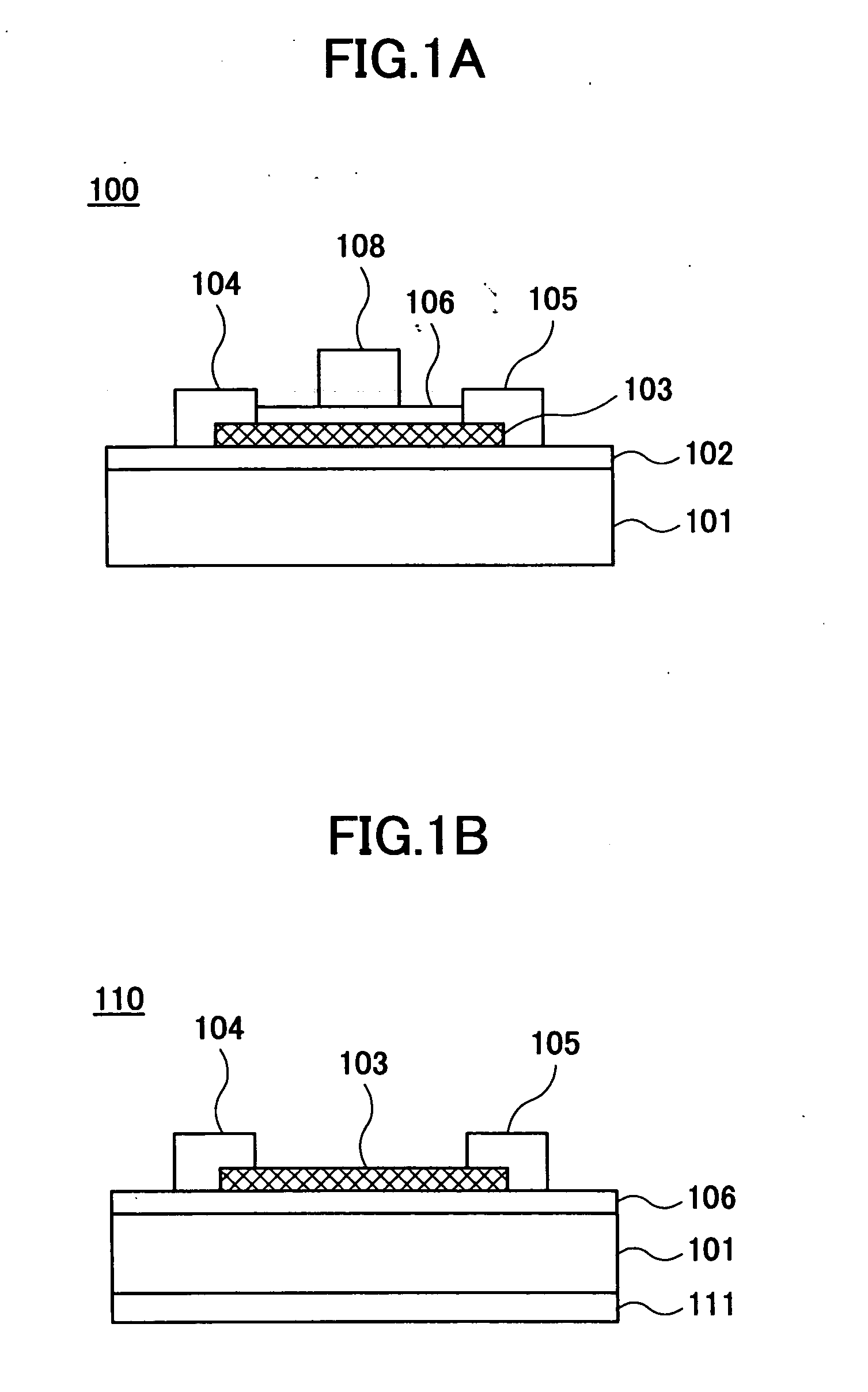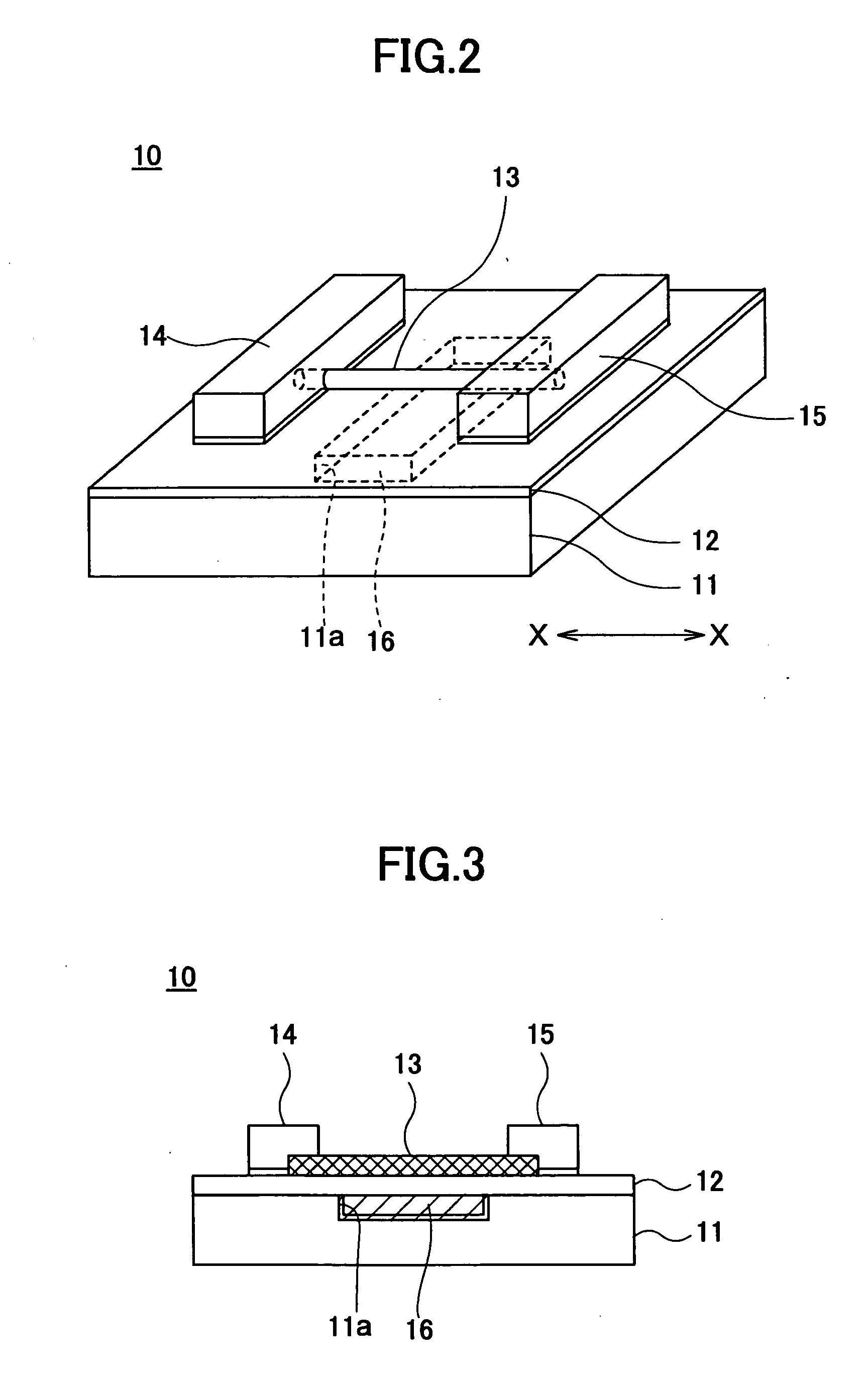Semiconductor device and semiconductor sensor
a semiconductor sensor and semiconductor technology, applied in the field of semiconductor sensors, can solve the problems of difficult to isolate adjacent fets from one another, carbon nanotubes may be chemically or physically damaged, and the electrical or mechanical characteristics of fets may be deteriorated, so as to achieve superior operation characteristics, high sensitivity, and high sensitivity
- Summary
- Abstract
- Description
- Claims
- Application Information
AI Technical Summary
Benefits of technology
Problems solved by technology
Method used
Image
Examples
first embodiment
[0034] the present invention is described.
[0035]FIG. 2 shows a perspective view of a semiconductor device according to the first embodiment of the present invention, and FIG. 3 shows an elevational sectional view of the semiconductor device shown in FIG. 2 taken along an X direction.
[0036] As shown in FIGS. 2 and 3, the semiconductor device 10 according to the first embodiment of the present embodiment includes a substrate 11, a gate electrode 16 formed in a groove 11a formed in a surface of the substrate 11, a gate insulating film 12 covering a surface of the. substrate 11 and the gate electrode 16, a carbon nanotube 13 formed on the gate insulating film 12 in such a manner that a length direction of the gate electrode 16 coincides with a longitudinal direction (the X direction shown) of the carbon nanotube 13, and a source electrode 14 and a drain electrode 15 formed apart from one another along the longitudinal direction of the carbon nanotube 13 and in contact with the carbon n...
second embodiment
[0063] the present invention is described next.
[0064]FIG. 6 shows an elevational sectional view of a semiconductor device in a second embodiment of the present invention. In the figure, the same reference numerals are given to parts corresponding to those described above for the first embodiment, and duplicated description is omitted.
[0065] As shown in FIG. 6, the semiconductor device 30 according to the second embodiment includes a substrate 11, a gate electrode 31 formed on a surface of the substrate 11, a gate insulating film 32 covering the surface of the substrate 11 and the gate electrode 31, a carbon nanotube 13 formed on the gate insulating film 32 in such a manner that the length direction of the gate electrode coincides with the longitudinal direction of the carbon nanotube 13, and a source electrode 14 and a drain electrode 15 formed on the gate insulating film 32 apart from one another in the longitudinal direction of the carbon nanotube 13 and electrically connected wi...
third embodiment
[0071] the present invention is described next.
[0072]FIG. 7 shows an elevational sectional view of a semiconductor device in a third embodiment of the present invention. In the figure, the same reference numerals are given to parts corresponding to those described above for the first and second embodiments, and duplicated description is omitted.
[0073] As shown in FIG. 7, the semiconductor device 40 according to the third embodiment includes a substrate 11, a gate electrode 16 formed in a groove 11a formed in a surface of the substrate 11, a high dielectric gate insulating film 41 formed on the gate electrode 16, an insulating film 42 formed on the substrate 11 surface except the area of the gate electrode 16, a carbon nanotube 13 formed on the high dielectric gate insulating film 41 and the insulating film 42 in such a manner that the length direction of the gate electrode coincides with the longitudinal direction of the carbon nanotube 13, and a source electrode 14 and a drain ele...
PUM
| Property | Measurement | Unit |
|---|---|---|
| length | aaaaa | aaaaa |
| thickness | aaaaa | aaaaa |
| thickness | aaaaa | aaaaa |
Abstract
Description
Claims
Application Information
 Login to View More
Login to View More - R&D
- Intellectual Property
- Life Sciences
- Materials
- Tech Scout
- Unparalleled Data Quality
- Higher Quality Content
- 60% Fewer Hallucinations
Browse by: Latest US Patents, China's latest patents, Technical Efficacy Thesaurus, Application Domain, Technology Topic, Popular Technical Reports.
© 2025 PatSnap. All rights reserved.Legal|Privacy policy|Modern Slavery Act Transparency Statement|Sitemap|About US| Contact US: help@patsnap.com



